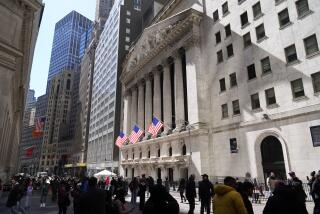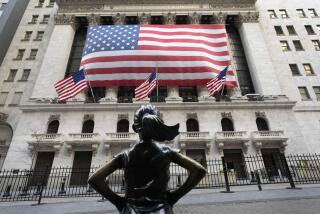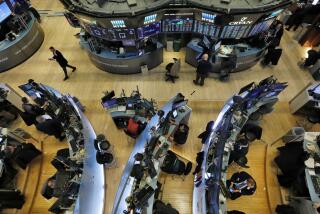Stocks end slightly lower for day, but are up for week
“Safety” wasn’t safe Friday.
A blockbuster U.S. jobs report sent investors fleeing traditional places of comfort: dividend-paying stocks, as well as bonds and gold. The selling left major indexes slightly lower.
When nervous investors crowd into safe-haven assets, it’s known on Wall Street as a “flight to safety.” On Friday, it was a flight from safety as investors grew more confident that the economy would grow.
“The January employment report was strong across the board,” said Michelle Girard, an economy at RBS Securities, in a note to clients. “The data were clearly very healthy.”
Gold fell more than 2 percent. As bond prices fell, the yield on the 10-year Treasury note jumped to 1.95 percent from 1.81 percent, a large move. Yields on shorter-term Treasury securities moved even more.
High-dividend utility stocks, one of the best performing parts of the market over the last 12 months, took a beating. The Dow Jones utility index, a collection of 15 utility companies, plunged 4 percent, its worst day since August 2011.
January’s jobs report startled investors who have become accustomed to near-zero interest rates. U.S. employers added 257,000 jobs last month and wages jumped by the most in six years, evidence that the job market is closer to full health. The gain was far better than the 230,000 jobs economists had expected.
The government also said hiring was far stronger in November and December than previously estimated. Wages, which have been mostly stagnant since the recession, rose at the fastest pace since 2008.
The Dow Jones industrial average fell 60.59 points, or 0.3 percent, to 17,824.29. The Standard & Poor’s 500 index lost 7.05 points, or 0.3 percent, to 2,055.47 and the Nasdaq composite fell 20.70 points, or 0.4 percent, to 4,744.40.
Understanding why a strong jobs report could cause the stock market to slide requires some counterintuitive thinking.
Unlike their counterparts in Europe and Asia, U.S. central bankers are poised to start raising interest rates. The exact timing of the Federal Reserve’s interest rate move is unknown, but every investor has an opinion on when and how it will happen. Strategists say the January jobs report, as well as the November and December revisions, gives the Fed more ammunition to justify an interest rate increase sooner rather than later.
“There’s an underlying nervousness in this market built on cheap money,” said Russ Koesterich, global chief investment strategist at BlackRock.
Trading Friday in Fed fund futures, securities that reflect investors’ views on when the Federal Reserve might change interest rates, suggested a rising likelihood that the Fed could raise interest rates as soon as June.
Near-zero interest rates have been a key factor driving the stock market’s dramatic rise since March 2009. By keeping interest rates low, the Fed has made bonds seem expensive and, by comparison, stocks cheap. So if interest rates are to rise, a richly-priced stock market would tend to be less attractive to investors, strategists say.
This dynamic was reflected in trading in utility stocks on Friday. Utility stocks typically pay consistently high dividends and tend to fluctuate less than other stocks, giving them some attributes of a bond. That makes them appealing to investors seeking income with relatively less risk compared with other parts of the stock market.
“It’s much more difficult to justify these high prices for utility stocks with yields rising like this,” Koesterich said.
Banks, which can profit from higher rates by charging more for loans, rose Friday.
Despite Friday’s downturn, it has been a good week overall for investors. The Dow ended up 3.8 percent and the S&P 500 climbed 3 percent. Stocks have now reclaimed the ground the lost in January.
The price of oil also rebounded this week. U.S. crude jumped 7 percent, its biggest gain since February 2011, during the Arab Spring and turmoil in Libya.
On Friday U.S. crude rose $1.21 a barrel, or 2.4 percent, to close at $51.69 a barrel. Brent, the international standard, gained $1.23, or 2.2 percent, to end at $57.80 a barrel in London.
The price of oil is still down by about half from last June because of a glut in global supplies.
In other metals trading, silver fell 50 cents, or 2.9 percent, to $16.69 an ounce and copper fell a penny to $2.59 a pound.
In other futures trading on the NYMEX:
— Wholesale gasoline rose 3.4 cents to close at $1.559 a gallon.
— Heating oil rose 3.3 cents to close at $1.839 a gallon.
— Natural gas fell 2.1 cents to close at $2.579 per 1,000 cubic feet. It was the eighth down day for natural gas out of the last 9, pushing natural gas to its lowest level since June of 2012.






